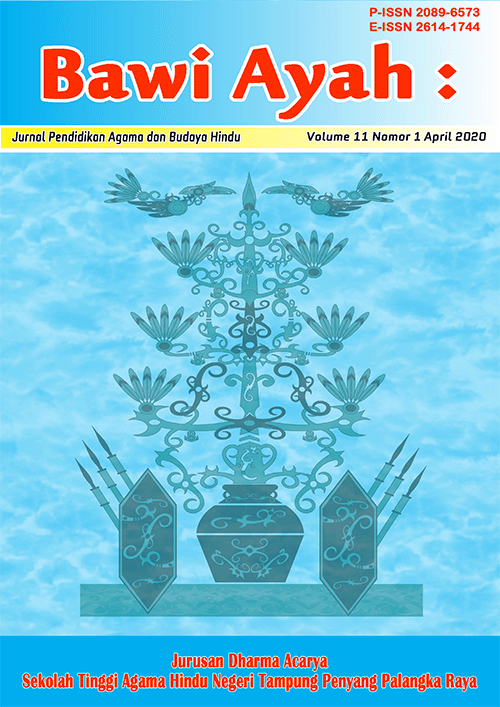MESAIBAN: TINJAUAN KONSEP PENDIDIKAN DALAM SEBUAH TRADISI
Abstract
Today's developments seem to be fast and simple in getting things done, so they also have an impact on various parts of life. Someone tends to want something quickly, so that sometimes makes less patient in achieving something. Mesaiban traditions are increasingly rarely carried out, due to the habit of buying food at stalls that are so easily found quickly. This has an effect on the lack of education gained through this, mesaiban is loaded with education. Various efforts need to be made so that this tradition can survive and be comprehended comprehensively by various groups, especially Hindus.
Mesaiban / ngejot is a term commonly used to express the implementation of daily yajna sesa with banana leaves as its base, rice, salt, side dishes, freshly cooked vegetables, water and incense as a tribute. The operation of the mesaiban can be interpreted as an expression of gratitude and form of stopping (Increasing Status) to animals that die while cooking or while doing activities. Banten saiban placed on plangkiran on the bed, cooking place, a place to store water or can also be aged, in the storage of rice or rice, home yard, monument, in place of sharpening stones (where sharpening kitchen utensils), in brooms (tools to sweep the dirt), in the place to pound the spice, bladed, where the mashing and collision. Education from the implementation of mesaiban namely Religious, Always Grateful, Ethical, Compassion, Respect and Tri Hita Karana
Downloads
References
Jaman, I. G. (2006). Tri Hita Karana dalam konsep Hindu. Pustaka Bali Post.
Kamiartha, I. M. A. (2009). Kamus Bali-Indonesia Bidang Istilah Sajen Bali dan Sarananya. Widya Dharma.
Krishna, A. (2018). Bhagavad-Gītā Transkreasi Baru untuk Zaman Baru. Pusat Studi Veda & Dharma Indonesia. https://bhagavadgita.or.id/#daftar_isi
Mertayasa, I. K. (2019). Yadnya Sebagai Penguatan Nilai Pendidikan Karakter. Tampung Penyang, XVII(1), 30–49.
Nala, I. G. N. (2007). Etika Hindu. UNHI Denpasar.
Netra, A. A. G. O. (2009). Tuntunan Dasar Agama Hindu. Widya Dharma.
Paramajaya, I. P. G. (2018). Implementasi Konsep Tri Hita Karana Dalam Perspektif Kehidupan Global : Berpikir Global Berperilaku Lokal. Purwadita, 2(2), 27–33. https://media.neliti.com/media/publications/268211-implementasi-konsep-tri-hita-karana-dala-28de05c4.pdf
Pendit, I. N. S. (1994). Bhagavadgita. Hanuman Sakti.
Pudja, G. dan Sudharta, T. R. (1995). Manawadharmasastra (Manu Dharmasastra) atau Weda Smerti Compedium Hukum Hindu. Hanuman Sakti.
Santoso, S. (1980). Indonesian Ramayana Volume I. International Academy Of Indian Culture. https://archive.org/details/RamayanaKakawinVol.1/page/n3/mode/2up/search/sargah+I
Sudani, N. K. (2017). Pemahaman Konsep Tattwa Dengan Ketrampilan Upakara Bhuta Yadnya, Pembelajaran Kooperatif Siswa Klas VIIIA SMP PGRI Gianyar 4 Di Bakbakan, Tahun 2013/2014. Dharmasmrti, XVII(2), 80–85.
Sukrawati dkk, N. M. (2006). Kaedah Beryajna, Orang-Orang Suci Dan Tempat Suci. Paramita.
Tirtarahardja, Umar dan Sulo, S. L. La. (2005). Pengantar Pendidikan. Rineka Cipta.
Titib, I. M. (2003). Teologi & Simbol-Simbol Dalam Agama Hindu. Paramita.
Wiana, I. K. (1997). Cara Belajar Agama Hindu Yang Baik. Yayasan Dharma Naradha.

This work is licensed under a Creative Commons Attribution 4.0 International License.












